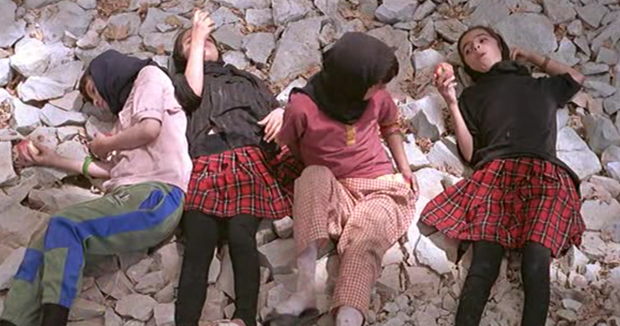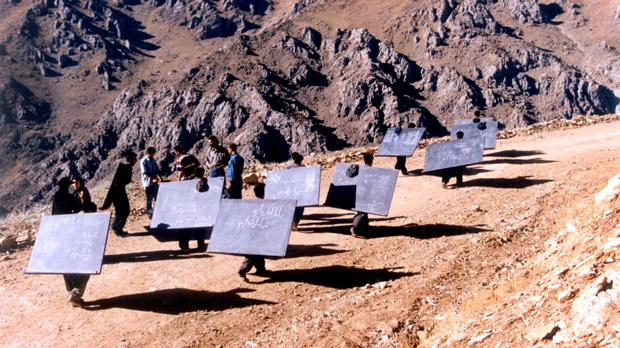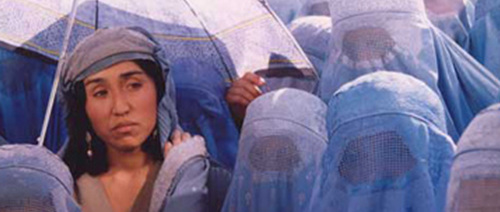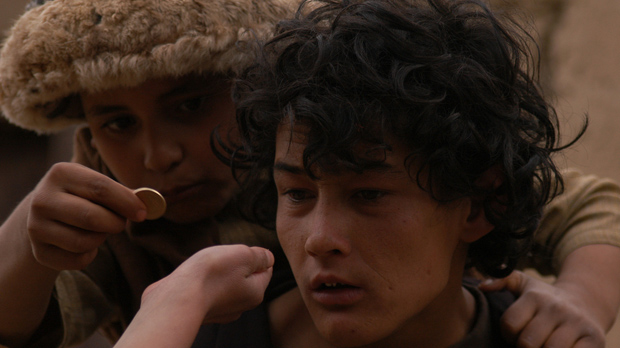As the daughter of Iran’s celebrated filmmaker Mohsen Makhmlabaf, Samira holds a unique prominence within the global cinema market, especially after breaking the Cannes world record of youngest director in the competition category. But her cult celebrity status as an award-winning, hijab-wearing, unapologetically-female director does more than turn the heads of inquisitive cinephiles. Both her family’s credentials and the artistic merit she has undeniably proven to fit the bill, lends her a different yet unmistakably valid voice that is representative of a new cinematic language that looks and speaks differently than other film cultures. Her bold articulation of marginal identities speaks volumes on behalf of a community of storytellers that has long been censored and silenced, yet has so much to offer. Muslim women have for centuries been limited by the veil of opportunity caught in limbo, not quite sure how to emerge from the shadows of a white man’s society, nor what to make of these newfound terrains spearheaded by cinematic prodigies like Samira Makhmalbaf. It is perhaps important to note that she garnered international attention not only at a very young age, but in a very short time, zealously placed under the cinematic spotlight for foregrounding the impoverished rhetoric of Middle Eastern women.
At the measly age of seventeen, with a couple of short video projects under her belt, Makhmalbaf set out to direct her first feature film The Apple (1998)–a stunning meditation on the antagonistic relationships between the public and private spheres, fiction and documentary narration, youth and the family. The film’s protagonists are two young girls who have never left the house, manipulating these dynamics through their complete unawareness and unconcern for the implications of their imprisonment, and through their inability to grasp the distinction between their home and the outside world. Other than establish these thematic precedents that Makhmalbaf will continue to dissect throughout her career, The Apple follows a long-standing Iranian tradition of using children as double-edged symbols for adults. Zahra and Massoumeh’s story is one of unveiling what was once veiled, of breaking down boundaries, and exploring new territory–stemming from the same breed of possibility offered by Makhmalbaf’s films themselves. Ever since its opening shot, Makhmalbaf calls attention to that which exists outside of what we’re told to look at–emphasized by the hand that reaches in from beyond the frame, watering a thirsty plant that has no other choice but to wait for it. For the remainder of the film, Makhmalbaf experiments with obstructed lenses and extreme perspectives–reiterating the claustrophobic verticalness of Tehran’s architecture where inhabitants peer into their neighbours yards, vendors catch money thrown to them through windows, children climb over fences to retrieve their balls, and children dangle attractive bait over the heads of oncoming passersby. She also refrains from telling us what is real and what is documentary, considering that the story was inspired from real life events, and that the actual people involved are playing themselves. For Makhmalbaf it was a matter of not being able to find any actors who could imagine what it was like for Zahra and Massoumeh to experience the world for the very first time– favoring the authenticity of their performance over impersonation or reenactment.

Her follow-up film, Blackboards (2000) lingers far outside the city of Tehran, and is set during the Iran-Iraq war. While it features mostly male characters and deals with the hardships of war, feminist critiques of nationalism and patriarchal power colour the fabric of the film. It’s about a group of teachers who wander the desert along the Kurdistan border between Iran and Iraq, in search of students with whom to share their knowledge. The handiness of the blackboards turns out to be crucial for everything except teaching: they use them as shields against gunshots, as stretchers to carry the sick, as dowry to marry a dying man’s daughter, as clotheslines to hang their wet clothes, and as splints for a wounded boy’s leg. In a world of conflict where people struggle to find enough food to eat and a safe play to sleep, learning to read and write becomes woefully irrelevant. Makhmalbaf’s concern for literacy and the Iranian education system evolves from its nuanced form in The Apple and will be carried with her throughout her career. While Blackboards aurally resembles The Apple’s refrain from using any extra-diegetic music that would relieve us from the austere background against which they are set, its visual elements display vast deviations from its predecessor. If space was vertically constructed in The Apple, imitating its metal bars and concrete structures, then here it’s the horizontal vistas and sublime landscapes what overwhelms the distant and barely visible human figures.

The vivid imagery of rubble and dust outlives Blackboards and finds a new home painting the devastated yet beautiful terrain of war-torn Afghanistan in At Five in the Afternoon (2003). Masqueraded as a terra incognita for Iran, the city of Kabul sets a stunning backdrop for the plight of women and the rise of unlikely ambition amongst a group of schoolgirls who dream of becoming president. Among these idealists is Noqreh– slightly older than the girls she goes to school with, and absolutely forbidden by her father to partake in such so-called profane and blasphemous shenanigans. Noqreh’s interest in diplomatic affairs leads her to a series of encounters with a refugee, a poet, a photographer, and a solider, each one more insightful than the next, though all dismissive of her intellectual interference with politics. However, to simply take these men’s repudiations of Noqreh’s appetite for feminine leadership at face value would be to underestimate Makhmalbaf’s subversion of the dominant representation of Afghan women. In early moments of the film, we hear a religious man’s pleas for forgiveness after seeing Noqreh’s unveiled face in the street– a double-edged moment that both disguises itself as pedagogic, but at the same time undermines this very discipline through Noqreh’s unresponsiveness. She couldn’t be bothered to cover herself up, and rather uses the veil to her own advantage– asserting her right to self-fashion as a modern and literate woman who can both appease her father’s wishes, and still strut a trendy pair of high heels. While in Eastern culture the veil is used to abide the modesty laws, and in Western cinema it enhances women’s desirability and fetishization, for Makhmalbaf, it is neither used to mystify nor eroticize the female characters, rather to assert their own sense of agency. If the unveiled female face is a site where both heterosexual desire resides and the piety of the male gaze is threatened, then only those who look at her are at risk. Contrary to popular belief, the female exhibitor, in this case Noqreh, is the unaffected party of this dual relationship between subject and object. These understated moments are emblematic of the ways in which Makhmalbaf uses cinema to transgress the limits of censorship–her own undercover pair of clandestine shoes, if you will.

Though the buried references to Federico Garica Lorca’s Lament for the Death of a Bullfighter (in the film’s very title and its repetition throughout) may slip past audiences unfamiliar with the Spanish poet, the symbolic baggage of disenfranchised Afghan women who act without capacity to change things carries a weight of its own. Void of any memorable dialogue, deeply drawn characters, surmounting drama, or an exciting climax, the film’s power relies solely on its piercing images and their ability to imprint your mind long after the film is over and the credits have rolled. The contrast between the soft blue folds that frame Noqreh’s rigid, unsmiling face, and the chalky ruins in which the refugees take shelter; the wounded and massacred airplane in which Noqreh and family temporarily reside, freckled with small punctures that bleed in the morning light; the symmetrical ancient pillars veiled with Noqreh’s faux-campaign photographs, as the sound of her pearly white shoes bounce off the crumbling walls of the decaying palace. While the deceitfully uplifting narrative proposes to rebuild a democratic Afghanistan in which woman takes the forefront, the grim visual elements suggest otherwise, and fully anchor the film through a profound sense of historical contingency. For all that the film’s ending is ambiguous and uncondemning of Noqreh’s future, her situation is all too real and all too indexical of the predetermined fate faced by the domination of not only patriarchal but also colonial regimes, to feel any inklings of optimism. As much as we would like to advocate her classroom rhetoric and visualize those pursuits coming to fruition, her nephew’s death from starvation, the horse’s withering from thirst, and their carriage’s incineration for warmth, remind us that Noqreh’s world is saturated with more prescient needs for survival that will always come first. In retrospect, her discordance with the random passersby takes on new meaning once we’ve seen the other side to their initially baffling apathy towards politics. It becomes a dizzyingly vicious cycle of obeying the rules in order to survive, and being on the verge of survival for having complied with such abusive rules in the first place.

These universally human themes that both transcend the nation, and yet walk out on the world on the strength of local spirit, culminate in Two Legged Horse (2008) and “Iran” (2002)– a segment of the larger collection September 11. Returning to the use of children as stand ins for adults, Makhmalbaf explores the complex dynamics of power and powerlessness, of lacking control on external influences and tagging along for the ride. In Two-Legged Horse, this theme is evoked through the disparate agencies between two boys– one boy, though physically disabled, holds the reigns, and the other possesses unlimited forgiveness for what he will tolerate for a measly dollar-a-day. In the latter film, of 11 minutes, 9 seconds and one frame, a group of naïve and innocently ignorant schoolchildren are expected to fathom the world event that their also young teacher has just caught wind of. The villagers’ inability to grasp what happened and how they will be affected by it mirrors its opening shot in which the community builds clay shelters in preparation for American retribution over something they don’t fully understand. The mutual fear shared between both the one in power (the master/America) from being overthrown, and the one upon which power is exuded (the horse-child/Iran) from being victimized is what feeds this sadomasochistic relationship.
Ranging from a variety of settings, and investigating a wide breadth of persistently (but not unconsciously) overlooked questions of Muslim female identity, the thread that ties Samira Makhmalbaf’s body of work together is distinctly interwoven with larger cultural issues. The cinematic language with which she chooses to speak, and the unheard voices she has invested in amplifying, mark Makhmalbaf’s indistinguishable role as an interlocutor of contemporary global cinema. For all the affliction and agony she brings to the screen, by virtue of the uncharted space her work has opened up, its message is finally most productive as a crucial reminder that there is always room for more.

